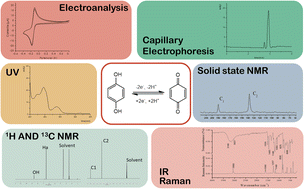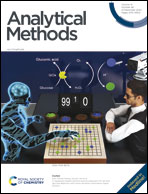Determination of hydroquinone and benzoquinone in pharmaceutical formulations: critical considerations on quantitative analysis of easily oxidized compounds†
Abstract
Hydroquinone is a skin-lightening agent used as an active ingredient in topical dermatological formulations prescribed for treating cutaneous diseases caused by hyperpigmentation. Despite being widely used, some toxicological aspects have been associated with these products, mainly due to overdosage and long-term use combined with the easy oxidation of hydroquinone. In this work, an investigative study has been done to gather enough data for selecting a quantitative analytical method for quality control purposes that considers the ease of oxidation not only within the product but also during the experimental procedures. After studying the influence of pH, reversibility, sampling, and standard solution preparation on the redox reaction between hydroquinone and benzoquinone by using spectroscopic, electrophoretic, and electroanalytical measurements, a reliable, fast, and selective chronoamperometric method was achieved. The optimized method was used for the analysis of samples, previously diluted in Britton–Robinson (BR) buffer (pH 5.5) and methanol (1 : 9, v/v), by applying a potential fixed at 0.4 V. A glassy-carbon working electrode, lab-made Ag/AgCl(sat) and platinum wire as a reference electrode and auxiliary electrodes, respectively, and BR buffer (pH 5.5) as supporting electrolyte were the additional experimental conditions used. Analytical performance parameters were verified to confirm the applicability of the new method (LOD 4.22 μmol L−1 and LOQ 14.1 μmol L−1; recovery mean value of 100% with 0.22% RSD). A gel topical formulation containing 4% (w/w) hydroquinone was analyzed through the developed method for determination of dosage and oxidation traces, and a content of 3.53 ± 0.095% (w/w) was found with no indications of degradation.



 Please wait while we load your content...
Please wait while we load your content...